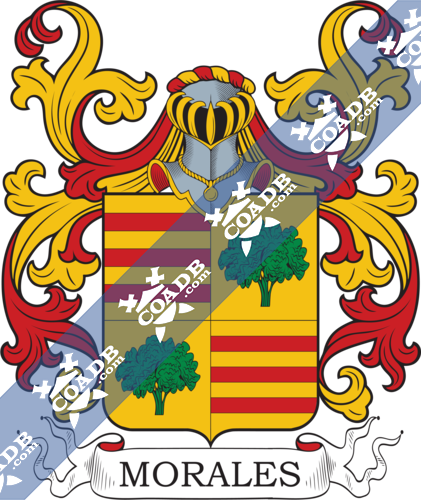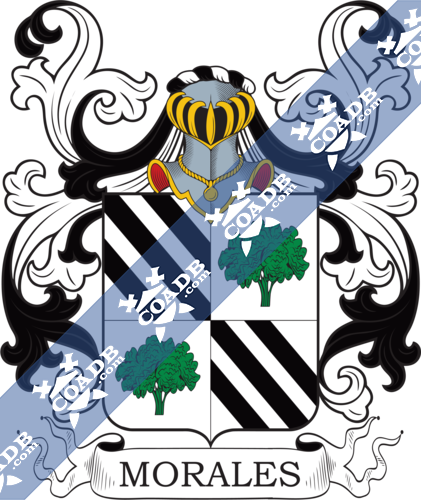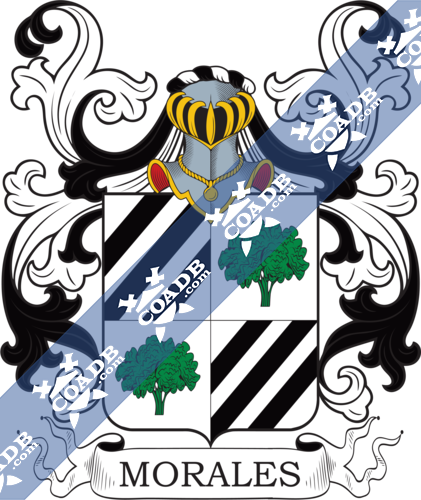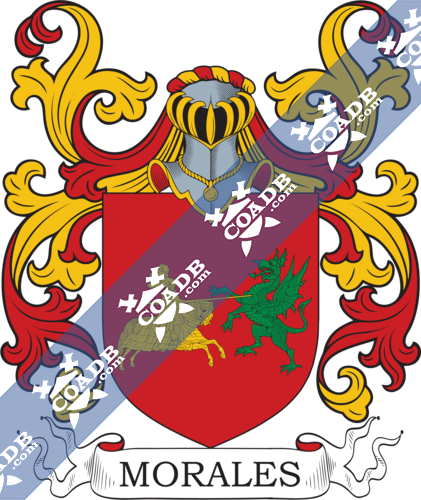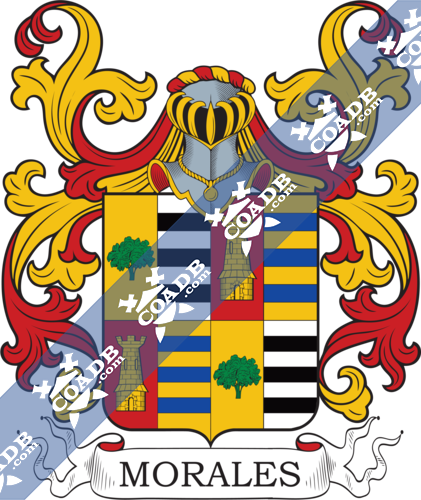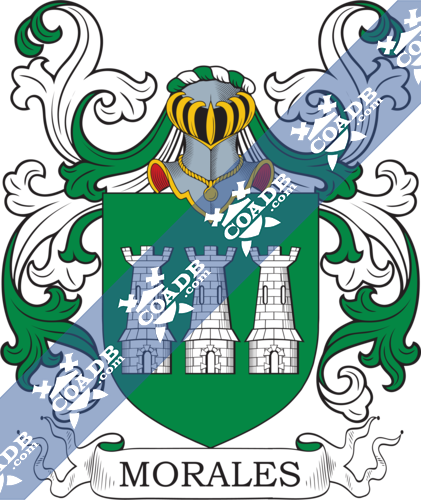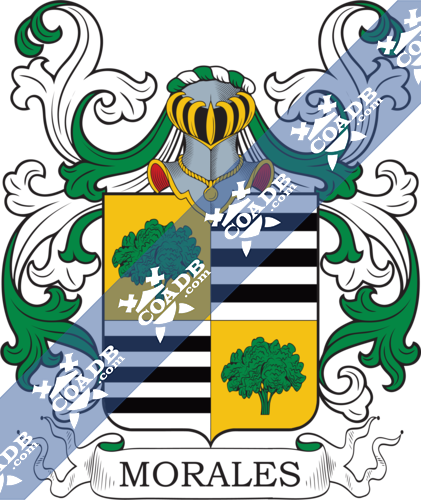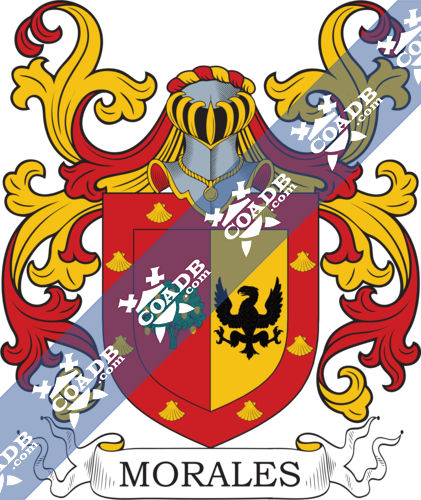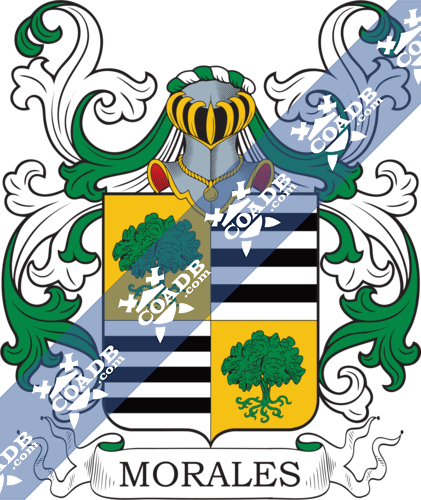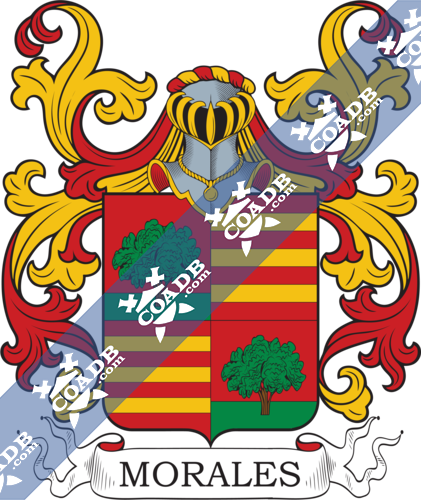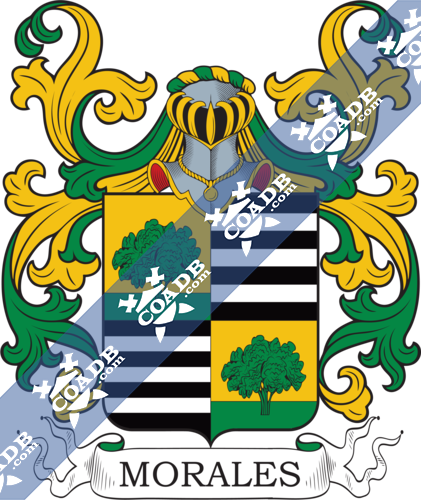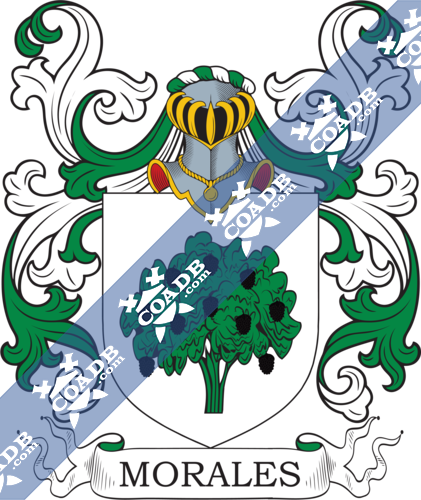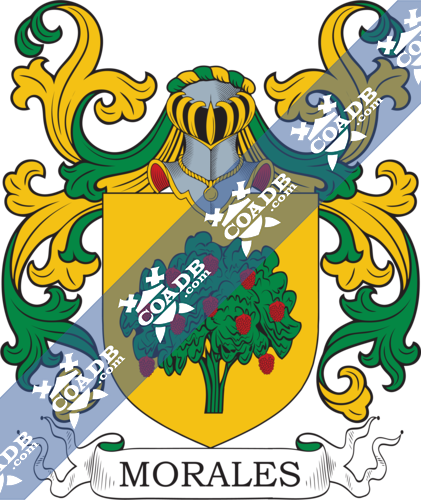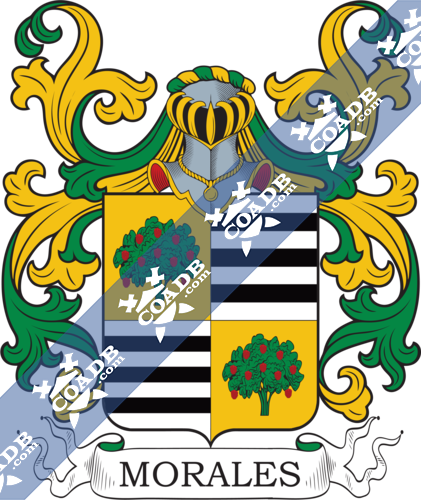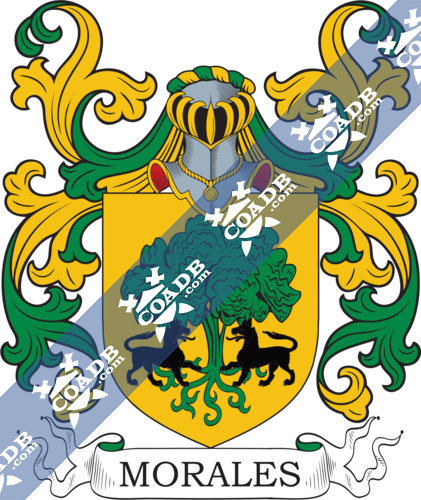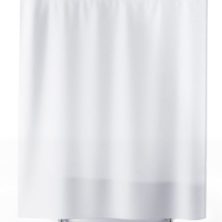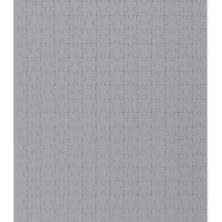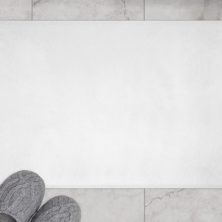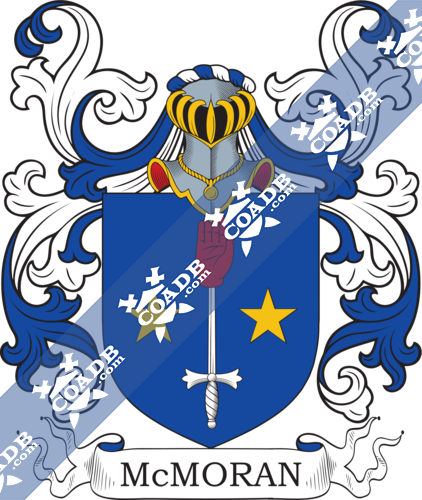Morales Family Crest, Coat of Arms and Name History
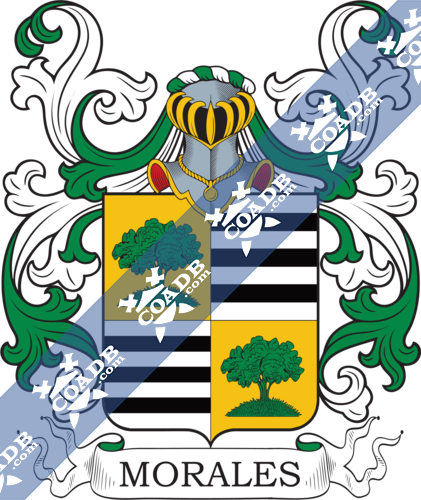
Morales Coat of Arms Gallery
Don’t know which Coat of Arms is yours?
We can do a genealogical research. Find out the exact history of your family!
Learn MoreSurname Meaning, Origin, and Etymology
Morales is a surname that comes from the old region of Spain, where many other last names have been created and then passed to the regions that this country colonized. This last name count on two possible origins, both very common in that time. The first theory claims that this is a topographical name that was used by a person who lived near a blackberry or mulberry bush, blackberry and mulberry can be translated into Spanish as “mora” which comes from the Latin word “morum”. The other possible origin of the surname is that it was used by the people who lived in a town, village or a location called “Morales” and the surname worked to indicate that the bearer is originally from that place. There were many towns named “Morales” in the medieval Spain.
The locational surnames were originally carried by the owners of the lands or by the lords of the manor and the topographical surnames were a simple way to identify the people according to a natural landscape or by road sign made by man, that is why this kind of surnames were some of the first ones that were created. Another important of Morales is that thanks to its origins, topographical or locational, the bearers don’t are necessarily part of the same family because the used of Morales is determined by the place where its carriers used to live. One of the oldest records of Morales is the one about Francisco de Morales who was a witness in a ceremony at “Nuestra Señora La Antigue” in Valladolid, Italy on October 29, 1570.
Spelling Variations
The medieval era was a period in which a single person could have many ways to be called thanks to the spelling variations, but why did this happen? Well, there are a few reasons. During this time in Europe there were many cultures colliding and overlapping in many territories, so they started to mix, along with their languages. Another reason was the lack of grammatical rules for a written format on many of those languages. Finally, there was also the way that many scribes wrote the words, they did it according to how they hear them, so each one could write the same words in different forms. All of this affect the surnames, so they count on spelling variations such as Cruz which some variants were Morales, Moral, Morilla, Moraleda, Moralez, Moreira, Mora, Morais and many others.
Popularity & Geographic Distribution
Despite its unusual origin, Morales is a surname that has a big popularity nowadays and it is used by many people. In fact, is the 203rd most common surname in the world and approximately 2,379,322 people carry it. It is most prevalent in Mexico and its highest density in Guatemala, which is also the second country with the biggest amount of Morales. The United States is the third country with the largest amount of Morales, followed by Spain in fourth place and Venezuela in fifth. All of this information is taken from the census of 2014.
Early Bearers of the Surname
There are records of some of the oldest bearers of Morales such as Gasper Morales, which son was christened in Cadiz, Spain on October 14, 1596, Andrés Morales a Spanish sailor who was born in 1477 and traveled with Christopher Columbus to America, Alonso de Morales treasurer of Fernando de Aragón from 1497 until 1503, Luis de Morales an important Spanish painter who was born in 1510, Ambrosio de Morales y Oliva a Spanish historian from the sixteenth century, Cristobal de Morales a playwright from Spain in the seventeenth century, Lope de Morales a court officer from Spain also during the seventeenth century and Cristobal de Morales a Spanish composer who was born in 1500.
History, Genealogy, and Ancestry
Among the many branches and lines of Morales, one that counts on a high-detail record is the one that belongs to Diego Sánchez de Morales, conqueror of Chile, who also helped to found Santiago. Diego Sánchez de Morales was born in Marchena, Spain in 1514, he was a son of Juan de Morales Negrete and Inés Rodríguez. Diego got married to Inés de León y Carvajal and they had six children, the first one was Diego de Morales y León Carvajal who was born in La Serena and got married to Ana María de Pastene y Seixas daughter of Juan Bautista Pastene and Ginebra de Rodrigo de Araya. The sons of his last marriage were Ginebra de Morales Pastene who got married to Rodrigo de Araya and Diego de Morales y Pastene who got married to Isabel Bravo de Villalbas y Rojas.
Diego and Isabel had one child: Juan Bravo de Morales who got married to María de Riberos y Castilla. From this last marriage would be born María de Morales Bravo y Riveros Fernández who got married to Pedro de Cortés de Monroy y Zavala, Diego de Morales y Riberos, who died while still being an infant and Juan de Morales y Riberos who also died young.
The second child of Diego Sánchez de Morales was Juan de Morales Negrete who was born in La Serena in 1567 and got married twice. The first time he got married to María de Grajales Avalos Téllez and after she died, he married María de Toledo y Herrera. The children of Juan were María Magdalena de Morales y Grajales who got married to Jerónimo de Cisternas y Mirada, son of Pedro de Cisternas Tobar and Ana de Miranda y Rueda, they didn’t have any children.
The second child of Juan de Morales Negrete was José de Morales Negrete y Herrera Toledo who got married to Beatriz Fernández Caballero y Hurtado de Cáceres. They had seven children, the first one was Juan de Morales Negrete y Caballero who was born in Santiago and got married to Magdalena Chacón y Cajal in 1673. Juan de Morales Negrete y Caballero and Magdalena Chacón y Cajal had seven children, the first one was José Ventura de Morales y Chacón who got married to Catalina Calvo de Encalada y Chacón, daughter of Diego Calvo de Encalada and Catalina Chacón y Carvajal. Together, José Ventura and Catalina Calvo had ten children: Francisco De Paula de Morales y Encalada who became a priest, María Josefa de Morales y Encalada who didn’t got married, Manuela de Morales y Encalada who didn’t have children, María Mercedes de Morales y Encalada who became a nun, Juan Antonio de Morales y Encalada who join the army but didn’t get married, Buenaventura de Morales y Encalada who also joined the military, José de Morales y Encalada who died single and without children, Clara de Morales y Encalada who got married to Diego Antonio de la Fontecilla y Palacios, Teresa de Morales y Encalada who got married to Francisco Javier de Arlegui y Lanz and Miguel de Morales y Encalada.
Josefa Ventura de Morales y Chacón was the second child of Juan de Morales Negrete y Caballero and Magdalena Chacón y Cajal. She got married to Miguel Alonso de Meneses y Bravo de Saravia. Then there was the third child, Juana de Morales y Chacón who got married to Luis de Avaria y Zavala, the fourth child was María de Morales y Chacón who didn’t get married, Antonia de Morales y Chacón who didn’t have children, Rosa de Morales y Chacón and Beatriz de Morales y Chacón.
The next one on the line of the Morales Negrete was Joaquín de Morales Negrete who became a priest, the following was Antonio de Morales Negrete y Caballero who join the army and got married to María Morillo y Cajal and together they had six children: José de Morales y Morillo, Ignacio Javiero de Morales y Morillo who married Rita María Josefa de Larreta y Ovalle and had three children of its own, they were: José de Morales y Larreta Ovalle, María Rosa de Morales y Larreta Ovalle and María del Carmen de Morales y Larreta Ovalle. The others children of Antonio de Morales were: Rosa de Morales y Morillo, Elvira de Morales y Morillo who married Manuel Vázquez de Osorio, Catalina de Morales y Morillo, and Francisca de Morales y Morillo.
The other children of Juan de Morales Negrete y Caballero and Magdalena Chacón were: Mariana de Morales Negrete who married Antonio Calero Carranza, Leonor Morales Negrete who got married to Juan Espinosa y Mieses, María Clara de Morales Negrete y Caballero who got married to Francisco de Villavicencio and José Morales Negrete y Caballero who got married to Ana María Villalón y Morales. This last marriage had a daughter, María Morales Fernández Caballero y Bocanegra.
The third child of Juan de Morales Negrete was Pedro de Morales Negrete y Toledo who was born in Santiago and got married to Mariana de Avendaño Valdivia y Cid Maldonado, daughter of Francisco de Avendaño Valdivia y Félix and Francisca Cid Maldonado de la Corte, however Pedro didn’t have a child with Mariana, he had it with María Magdalena Méndez de los Reyes. They had a child Inés de Morales y Méndez. The fourth and last child of Juan de Morales Negrete was Mariana de Morales Negrete y Toledo who was born in Santiago and got married to Martín de Espinosa Santander y Olivares.
Back to the main line, the children of Diego Sánchez de Morales and Inés de León y Carvajal, the following are: Isabel de Morales y León Carvajal who was born in La Serena and got married to Miguel Gómez de Silva, Mariana de Morales y León Carvajal who also was born in La Serena and got married to Alonso de Córdova y Merlo, son of Alonso de Córdova and Olaya de Merlo. Finally, the last two were Luisa de Morales y León Carvajal who got married to Antonio Chacón, son of Rodrigo Chacón and Inés Gómez, and Ines de León y Carvajal who got married to Lope de la Peña.
Early American and New World Settlers
Since the 15th century, a lot of Europeans have traveled to America looking for a new life, they have brought their culture, their traditions, their lifestyles and of course, their surnames. This is how in America people started to use the last names from the old continent. Here are some of the carriers of Morales who arrived in America over the centuries. In the 16th century Isabel de Morales arrived in New Spain in 1562, María de Los Angeles, landed in Nicaragua in 1563, Gabriel de Morales arrived in Honduras that same year and Elvira de Morales arrived in New Spain in 1566 with two children
During the 19th century other people with the Morales arrived in America such as Manuel Morales who landed in Puerto Rico in 1802, Miguel de Morales arrived in the new continent in 1811, Inés de Morales arrived in America in 1813, Anton de Morales landed in America in 1814 and Jose Miguel Morales arrived at Puerto Rico in 1821.
Mottoes
We were unable to locate any documented mottoes for the Morales family.
Grantees
We were unable to locate any documented grantees for the Morales family.
Notables
Some of the carriers of Morales have played important roles in different fields such as Amado Morales (b. 1947) a javelin thrower from Puerto Rico, Dan Morales (b. 1956) an American politician from Texas, Evo Morales (b. 1959) the current President of Bolivia, Javier Morales (b. 1980) a football player from Argentina, Mario Morales (b. 1960) Puerto Rican basketball player, Guillermo Enrique Morales (1937-2017) a Venezuelan singer, José Jurado Morales (b. 1900) a Spanish poet and journalist, David Sánchez Morales (1925-1978) an American CIA operative who worked in Cuba, Pablo Morales (b. 1964) an American Olympic swimmer and many others.
To receive a complete surname meaning report by PDF you can order our SURNAME MEANING PACKAGE for $129. This report is great to share with family and friends. It includes everything you see above plus any other information we can find on the specified surname. It does take approximately 10 to 15 days for us to complete this custom report.
To receive a direct lineage & coat of arms search for your specific line(s) you can order one of our GENEALOGY PACKAGES ranging in price from $249 to $999. All research is completed by a professional genealogist with over 30 years’ experience. All reports and coat of arms files are sent by email in PDF and JPG format.
Blazons & Genealogy Notes
1) Castille, Catalogne, Valence, Andalousie – Écartelé aux 1 et 4 d’or à un mûrier de sinople sur une terrasse isolée du même aux 2 et 3 d’argent à trois fasces de sable Ou Sur le tout d’or à l’aigle éployée de sable becquée membrée et diadémée d’or. English: Quarterly 1st and 4th or with a blackberry bush vert on a mount separated from the base of the same 2nd and 3rd argent three bars sable (alternatively) overall or with an eagle displayed sable beaked legged and haloed or.
2) La casa primitiva del lugar de Medio Cudeyo, Merindad de Trasmiera, trae: Escudo cuartelado: 1º y 4º, de oro, con un moral de sinople, y 2º, y 3º , de plata, con tres fajas, de sable. Privativas del linaje de Morales, originario de Burgos, radicado en Soria y posteriormente establecidos en Gran Canaria, pasando a La Habana a principios del siglo XVIII, y una de cuyas líneas descendientes contemporáneas está representada por don Miguel Antonio Recio de Morales y González-Abreu, Marqués del Valle de Siciliana y de la Real Campiña, vecino de Miami, Florida (EE.UU.)
3) Otros traen: Escudo cuartelado: 1º y 4º, de oro, con un moral arrancado, de sinople, y 2º, y 3º, de plata, con tres fajas, de sable. Privativas del linaje de Morales, originario de Baena (Córdoba), y una de cuyas líneas descendientes estaba representada por don Santiago de Morales Talero, vecino de Arjona (Jaén).
4) Los Morales de la villa de Berja, traen: Escudo cuartelado: 1º y 4º, de gules, con un moral de su color, terrasado de sinople y 2º, y 3º, también de gules, con tres fajas, de oro.
5) Los Morales de la villa de Berja, también traen: Escudo cuartelado: 1º y 4º, de oro, con un moral de sinople, terrasado de lo mismo y 2º, y 3º, de sable, con tres fajas, de plata.
6) Los Morales de la casa solar de Calatayud, extendidos a varias poblaciones aragonesas, traen: En campo de plata, un moral de sinople, frutado de sable.
7) Los Morales de la casa solar de Calatayud, extendidos a varias poblaciones aragonesas, también traen: En campo de oro, un moral de sinople, frutado de gules.
8) Los Morales de la casa solar de Calatayud, extendidos a varias poblaciones aragonesas, también traen: Escudo cuartelado: 1º y 4º, de oro, con un moral de sinople, frutado de gules, y 2º, y 3º, de plata, con tres fajas, de sable.
9) Otros traen: De oro, con un moral de sinople, arrancado, y a cada lado del tronco un lobo de sable, afrontado.
10) Los “Morales Somos” y los “Morales Hondoneros,” de Soria: Escudo cuartelado: 1º y 4º, de oro, con tres fajas de gules y 2º y 3º, también de oro, con una morera de sinople.
11) Para Fernando González-Doria, los Morales, traen: Escudo cuartelado: 1º y 4º, de plata, tres bandas de sable, y 2º, y 3º, de plata, un moral de sinople.
12) Radicado en La Habana (Cuba): Escudo bandado de oro y gules, resaltado de un árbol arrancado, de sinople.
13) Otros traen: Escudo cuartelado: 1º y 4º, de oro, un árbol de cinco copas, de sinople, arrancado, y 2º y 3º, de plata, tres fajas, de sable.
14) Otros traen: Escudo cuartelado: 1º y 4º, de plata, tres barras, de sable, y 2º y 3º, de plata, un moral de sinople.
15) Otros traen: Escudo jironado de plata y sinople.
16) Otros traen: En campo de gules, un caballero, de oro, alanceando a un dragón, de sinople.
17) Otros Morales, en Chile, traen: Escudo cuartelado: 1º y 4º, de oro, con un moral de sinople; medio partidos, de plata, con tres fajas de sable, y 2º y 3º, de gules, con una torre de oro; medio partidos, de oro, con tres fajas de azur.
18) Los Morales que pasaron a la ciudad de Guadalajara, traen: Escudo partido: 1º, de gules, con una torre de plata, rayada de sable, sobre ondas de agua de azur y plata, y sumada de una bandera, también de plata, y 2º, de plata, con una morera, de sinople.
19) Originario de Illescas (Toledo) y radicado en Toledo y Madrid: En campo de sinople, tres torres, de plata y puestas en faja.
20) Otros Morales, traen : Escudo partido: 1º, de gules, con una moral de sinople frutado de oro, y 2º, de oro , con un águila de sable; bordura general de gules, con ocho veneras de oro.

